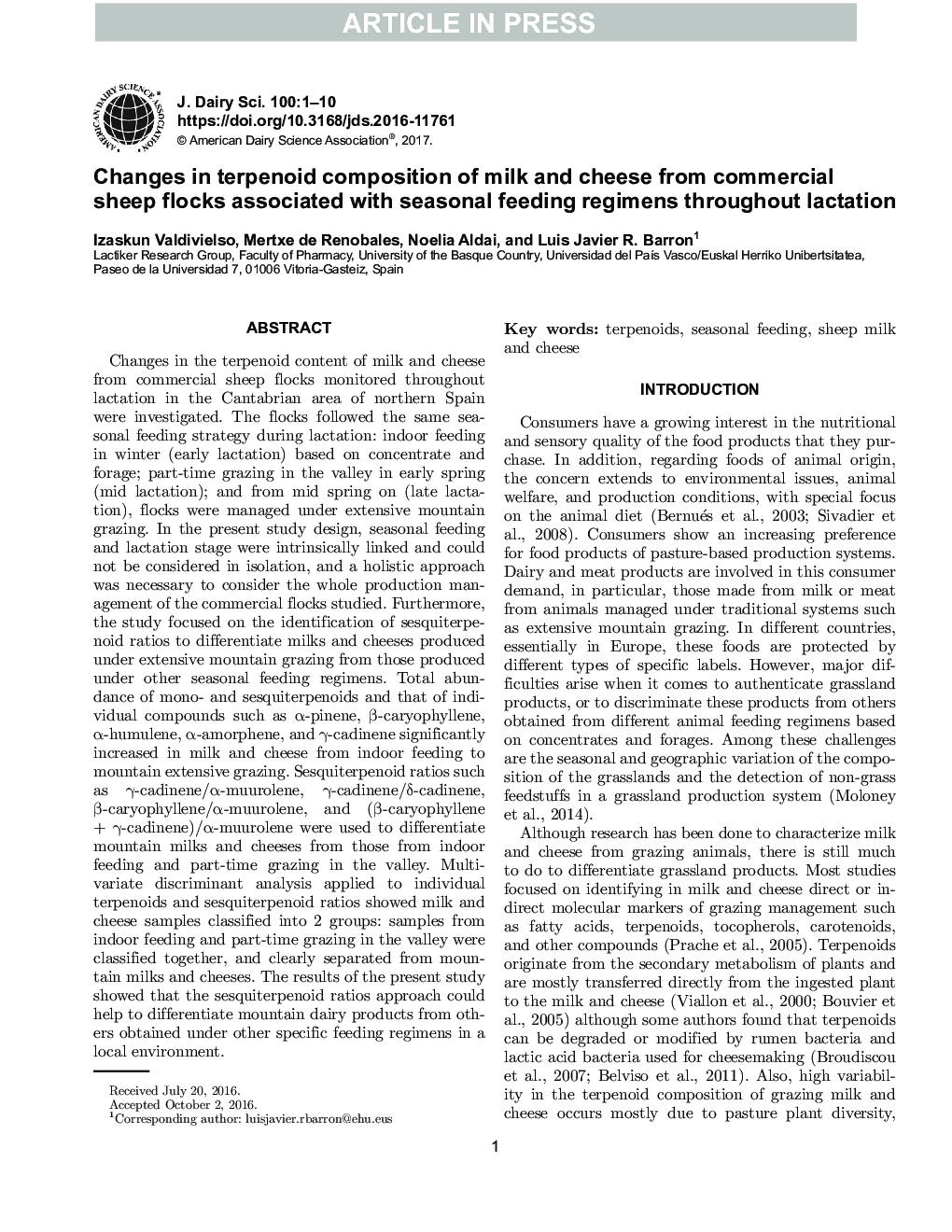| کد مقاله | کد نشریه | سال انتشار | مقاله انگلیسی | نسخه تمام متن |
|---|---|---|---|---|
| 5542553 | 1402520 | 2017 | 10 صفحه PDF | دانلود رایگان |
عنوان انگلیسی مقاله ISI
Changes in terpenoid composition of milk and cheese from commercial sheep flocks associated with seasonal feeding regimens throughout lactation
ترجمه فارسی عنوان
تغییرات در ترکیب ترپنوئید شیر و پنیر از گله های گوسفند تجاری که به رژیم های فصول تغذیه در طول شیردهی
دانلود مقاله + سفارش ترجمه
دانلود مقاله ISI انگلیسی
رایگان برای ایرانیان
کلمات کلیدی
موضوعات مرتبط
علوم زیستی و بیوفناوری
علوم کشاورزی و بیولوژیک
علوم دامی و جانورشناسی
چکیده انگلیسی
Changes in the terpenoid content of milk and cheese from commercial sheep flocks monitored throughout lactation in the Cantabrian area of northern Spain were investigated. The flocks followed the same seasonal feeding strategy during lactation: indoor feeding in winter (early lactation) based on concentrate and forage; part-time grazing in the valley in early spring (mid lactation); and from mid spring on (late lactation), flocks were managed under extensive mountain grazing. In the present study design, seasonal feeding and lactation stage were intrinsically linked and could not be considered in isolation, and a holistic approach was necessary to consider the whole production management of the commercial flocks studied. Furthermore, the study focused on the identification of sesquiterpenoid ratios to differentiate milks and cheeses produced under extensive mountain grazing from those produced under other seasonal feeding regimens. Total abundance of mono- and sesquiterpenoids and that of individual compounds such as α-pinene, β-caryophyllene, α-humulene, α-amorphene, and γ-cadinene significantly increased in milk and cheese from indoor feeding to mountain extensive grazing. Sesquiterpenoid ratios such as γ-cadinene/α-muurolene, γ-cadinene/δ-cadinene, β-caryophyllene/α-muurolene, and (β-caryophyllene + γ-cadinene)/α-muurolene were used to differentiate mountain milks and cheeses from those from indoor feeding and part-time grazing in the valley. Multivariate discriminant analysis applied to individual terpenoids and sesquiterpenoid ratios showed milk and cheese samples classified into 2 groups: samples from indoor feeding and part-time grazing in the valley were classified together, and clearly separated from mountain milks and cheeses. The results of the present study showed that the sesquiterpenoid ratios approach could help to differentiate mountain dairy products from others obtained under other specific feeding regimens in a local environment.
ناشر
Database: Elsevier - ScienceDirect (ساینس دایرکت)
Journal: Journal of Dairy Science - Volume 100, Issue 1, January 2017, Pages 96-105
Journal: Journal of Dairy Science - Volume 100, Issue 1, January 2017, Pages 96-105
نویسندگان
Izaskun Valdivielso, Mertxe de Renobales, Noelia Aldai, Luis Javier R. Barron,
